Research on Cooperative Behavior of Green Technology Innovation in Construction Enterprises Based on Evolutionary Game
Abstract
:1. Introduction
- There is a lack of cooperation research related to green technology innovation in the construction field. There have been many studies on innovation cooperation, and the number of research objects is gradually increasing, but there are fewer studies in the construction field. At present, most of literatures related to the green technology innovation of construction enterprises remain in the aspects of the principle analysis and practical application of a certain green building technology [20]. However, with the concern for environmental problems such as energy loss and pollution damage in the construction industry, its cooperative research has important practical significance to promote the application and development of its green technology innovation.
- There is a lack of research on the construction enterprise as the main body of cooperation. Since construction enterprises often do not occupy a dominant position in the innovation process, the existing research is mostly conducted for other cooperation subject types, such as industry–university research innovation cooperation and university research cooperation alliances [21]. However, in recent years, with the trend of promoting enterprises as the main body of innovation, it is necessary to study inter-enterprise innovation cooperation.
- The research on the influencing factors of cooperation strategy selection and its mechanism of action is not comprehensive and in-depth enough [22], and the relevant research on construction enterprises is also lacking. Numerous relevant studies of enterprise have found that the innovation capability, experience and reputation of enterprises can affect the cooperative behavior strategy and results through the willingness to cooperate [23]. Secondly, information sharing is one of the important basis for inter-enterprise cooperation and coordination [24]. Adequate sharing among enterprises can produce double spillover effects in different situations [25], which has a positive impact on the choice of cooperative behavior strategies [26,27]. In addition, academics generally agree that the benefit distribution mechanism is also a key factor affecting cooperative relationships [28]. In the green technology innovation cooperation situation of different types of subjects, such as enterprises, universities and research institutions, benefits and costs also have an impact on cooperation behavior [29]. Different benefit allocation strategies have different effects on the promotion of enterprise cooperation behavior. Therefore, it is important to study how to find the best benefit allocation strategy [30]. The government, as an important intermediary of enterprise innovation cooperation, can promote the efficiency and success of enterprise technology innovation cooperation by adopting reasonable punishment mechanisms [31,32,33]. Research has confirmed that appropriate government incentives and punishments can play a positive role in promoting cooperation stability [33].
2. Model Building
2.1. Problem Description and Model Assumptions
- The cooperation object is usually not completely symmetrical. Green technology innovation in the construction industry is usually tailored to the needs of specific engineering projects. The different technical requirements and site conditions of engineering construction can lead to more complex green technology innovation in construction enterprises. In order to improve technology and speed up innovation, the organization involved in green technology innovation cooperation usually comes from a wide range of sources and may differ in terms of enterprise nature, organization type and business operations. This can result in differences in resources, capabilities, knowledge, and technology, which makes it difficult for participants in green technology innovation cooperation to meet the conditions of complete symmetry.
- Having reciprocity preferences—both the direct goodwill behavior of each other in reciprocity theory (direct reciprocity) [34,35] and the corporate reputation effect formed through a third party (indirect reciprocity) [36] can be used to explain the establishment of trust foundation, thus promoting the green technology innovation cooperation behavior in construction enterprises. Due to the existence of direct reciprocity, successful experiences in engineering project cooperation are beneficial to strengthen the degree of trust among construction enterprises in green technology innovation cooperation. In other words, when enterprises have had successful experiences in cooperation and have established a deeper understanding of each other during the cooperation process, this cooperation history can strengthen trust among enterprises, and enterprises will reciprocate for each other’s friendly behavior, prompting the generation of the green technology innovation behavior. In addition, through indirect reciprocity, enterprises can obtain a good corporate reputation and indirect returns from other beneficiary enterprises [37,38]. In addition, they can establish a strong cooperative relationship with companies that have not had previous contact or cooperation at a lower cost. If the corporate reputation is unknown or unreliable, the enterprises will build trust in the cooperation process by increasing the transaction cost, etc., in order to achieve the purpose of controlling the cooperation risk.
- Having a strong spillover effect—green technology innovation cooperation among construction enterprises can generally be carried out in the forms of cooperative engineering projects, technological innovation cooperation results, a joint publication of papers or writing patents, etc. However, since cooperation in engineering projects is the most common cooperation mode among construction enterprises at present, the development of green technology innovation cooperation among construction enterprises is mainly based on the actual needs in cooperative engineering projects [39]. In the process of engineering project cooperation, due to the long construction period and many participating subjects, the green technology innovation cooperation is more uncertain and unstable, and an external spillover phenomenon is more likely to occur. It is generated by voluntary sharing of knowledge, technology, and other resources, which can promote mutual learning between each other and improve the efficiency of green technology innovation. However, knowledge, technology, and other innovation resources may also be learned and imitated by negative cooperative enterprises or other enterprises through involuntary diffusion, leading to the damage of active cooperative enterprises’ own interests. Besides, the enterprises’ motivation for green technology innovation can also be easily hit by the opportunistic behavior generated by spillover.
2.2. Revenue Matrix
2.3. Replicator Dynamics Equation
3. Model Analysis
3.1. Replicator Dynamics Equation Analysis
3.2. Analysis on the Evolutionarily Stable Strategies of Each Construction Enterprise
3.3. Analysis on the Evolutionarily Stable Strategy between the Two Sides of Construction Enterprises
4. Numerical Simulation
4.1. Cooperation Willingness
4.2. Sharing Level
4.3. Income Distribution
4.4. Punishment Mechanism
5. Conclusions, Limitations and Future Research
5.1. Conclusions
- Improve the cooperation willingness and emphasis of enterprises. The government should introduce and improve the relevant supporting policies, regulations and systems for green technology innovation cooperation. The construction enterprises should establish target management and incentive mechanisms in the cooperation process.
- Strengthen communication among enterprises and improve the sharing level. Construction enterprises should establish a communication system, set up a good channel for information exchange to convey solutions to problems and information in a timely manner such as regular talks and research.
- Enhance intellectual property protection to protect the interests of construction enterprises. In the process of adequate communication and information exchange, the enterprises should have a basic awareness of intellectual property protection for the confidential and important technologies, commercial brands and other intangible assets. Meanwhile, the government should establish an effective monitoring and intellectual property protection system.
- Optimize the benefit distribution mechanism and enhance the sense of fairness of enterprises. Cooperation enterprises should strengthen communication and consultation on the scope, proportion and manner of income distribution before establishing a cooperative relationship, such that a mutually satisfactory and reasonable income distribution plan can be determined in cooperation.
- Establish an assessment and evaluation mechanism to implement penalties. Construction enterprises should regularly assess the performance and evaluate the contribution degree of cooperation partners. In addition, the construction industry can establish a cooperation credit system to regularly assess the cooperation performance of construction enterprises. From there, penalties such as charging default fees or raising the cooperation deposit can be imposed on construction enterprises that adopt opportunistic behavior.
5.2. Limitations and Future Research
Author Contributions
Funding
Institutional Review Board Statement
Informed Consent Statement
Data Availability Statement
Acknowledgments
Conflicts of Interest
References
- Zeng, F.Y. Basic Framework of Green Development. Environ. Prot. 2017, 45, 43–47. [Google Scholar]
- Cheng, B.Q.; Lu, K.; Li, J.C.; Chen, H.; Luo, X.; Shafique, M. Comprehensive assessment of embodied environmental impacts of buildings using normalized environmental impact factors. J. Clean. Prod. 2021, 130083. [Google Scholar] [CrossRef]
- Ma, Y.H.; Kong, L.K.; Yang, X.M.; Lin, C. Innovation Cooperation Network Evolution About Green Building Technology With Government Intervention: Based on Evolutionary Game Theory. IEEE Access 2021, 9, 142. [Google Scholar] [CrossRef]
- Brawn, E.; Wield, D. Regulation as a means for the social control of technology. Technol. Anal. Strateg. Manag. 1994, 3, 497–505. [Google Scholar] [CrossRef]
- Dong, Z.Q.; Tan, Y.S.; Wang, L.H.; Zheng, J.; Hu, S. Green supply chain management and clean technology innovation: An empirical analysis of multinational enterprises in China. J. Clean. Prod. 2021, 310, 127377. [Google Scholar] [CrossRef]
- The Beijing Municipal Commission of Reform and Development Implementation Plan for Building a Market-Oriented Green Technology Innovation System. 2020. Available online: http://fgw.beijing.gov.cn/gzdt/fgzs/xwfb/202006/t20200605_1917401.htm (accessed on 27 December 2021).
- Aguilera-Caracuel, J.; Ortiz-de-Mandojana, N. Green Innovation and Financial Performance on Institutional Approach. Organ. Environ. 2013, 26, 365–385. [Google Scholar] [CrossRef]
- Zhang, W.; Lu, P.; Wang, Y. Influence Factors of the Extension of Green Buildings: Empirical Research from Construction. Ind. Constr. Econ. 2008, 2, 28–32. [Google Scholar]
- Marin, G. Do eco-innovations harm productivity growth through crowding out? Results of an extended CDM model for Italy. Work. Pap. 2012, 43, 301–317. [Google Scholar] [CrossRef] [Green Version]
- Wu, X.B.; Yang, F.M. The Innovation and diffusion of green technology. Sci. Res. Manag. 1996, 1, 38–41. [Google Scholar]
- Fusfeld, H.I.; Haklisch, C.S. Cooperative R & D for competitors. Harv. Bus. Rev. 1985, 63, 60–76. [Google Scholar]
- Fu, J.J. Technological Innovation; Tsinghua University Press: Beijing, China, 1988. [Google Scholar]
- Yu, X.N.; Lan, Y.F.; Zhao, R.Q. Strategic green technology innovation in a two-stage alliance: Vertical collaboration or co-development? Omega-Int. J. Manag. Sci. 2021, 98, 102–116. [Google Scholar] [CrossRef]
- Zhang, X.Y. Research on the Structure Analysis and Evolution Process of Building Technology Innovation Network—Taking Solar Building Integration as an Example. Master’s Thesis, Hunan University of Science and Technology, Hunan, China, 2015. [Google Scholar]
- Guo, Y.Q.; Zou, H.; Liu, Z. Behavioral Analysis of Subjects for Green Technology Innovation: A Tripartite Evolutionary Game Model. Math. Probl. Eng. 2021, 2021, 14. [Google Scholar] [CrossRef]
- Yang, T.; Xue, S. Endogenous mechanism of green Transformation driving in construction enterprises from the perspective of technology and system interaction. Mod. Manag. 2020, 3, 16–19. [Google Scholar]
- Su, L.P.; Gao, S. Review on the Research of Green Technology Innovation of Enterprises. Sci. Technol. Ind. 2021, 21, 166–169. [Google Scholar]
- Long, X.; Chen, Y.; Du, J.; Oh, K.; Han, I.; Yan, J. The effect of environmental innovation behavior on economic and environmental performance of 182 Chinese firms. J. Clean. Prod. 2017, 166, 1274–1282. [Google Scholar] [CrossRef]
- Liang, X.; Lu, W.; Wu, Z. Effects of collaboration networks on technology innovation in the solar photovoltaic(PV) sector: A case study of China. J. Green Build. 2020, 3, 139–157. [Google Scholar]
- Zhang, Y.Q.; Wang, H.; Gao, W.J.; Wang, F.; Zhou, N.; Kammen, D.M.; Ying, X. A Survey of the Status and Challenges of Green Building Development in Various Countries. Sustainability 2019, 11, 5385. [Google Scholar] [CrossRef] [Green Version]
- Zheng, H.E.; Qu, J.J.; Li, B. Evolutionary Game Analysis of Cooperative Innovation Behaviors of Green Supply Chain Enterprises Considering Government Rewards and Punishments. Ecol. Econ. 2021, 37, 62–70. [Google Scholar]
- Mukherjee, A.; Carvalho, M. Dynamic decision making in a mixed market under cooperation: Towards sustainability. Int. J. Prod. Econ. 2021, 241, 108270. [Google Scholar] [CrossRef]
- Kaufman, A. Collaboration and technology linkages: A strategic supplier typology. Strateg. Manag. J. 2000, 21, 649–663. [Google Scholar] [CrossRef]
- Cabon-Dhersin, M.L.; Ramani, S.V. Does trust matter for R&D cooperation? A game theoretic examination. Theory Decis. 2004, 57, 143–180. [Google Scholar]
- Yang, F.L. Information sharing and collaboration in the supply chain. China New Telecommun. 2020, 57, 68. [Google Scholar]
- Janus, S.S. Becoming a Knowledge-Sharing Organization; World Bank Publications: Washington, DC, USA, 2016. [Google Scholar]
- Jiao, S.L. Game analysis of inter-firm cooperation in technological innovation. Sci. Technol. Manag. Res. 2007, 5, 119–122. [Google Scholar]
- Wang, Y.H.; Liu, D.; Tian, P.Y. A study of the factors influencing the distribution of benefits in partnerships: A quantitative analysis based on CiteSpace mapping. China Storage Transp. 2020, 11, 115–118. [Google Scholar]
- Gao, G.K.; Gao, S.Q. Innovation analysis of industry-university-research cooperation based on evolutionary game. Sci. Technol. Manag. Res. 2010, 30, 4–6. [Google Scholar]
- Qin, Q.; Xu, F.; Song, B. Evolutionary Game Analysis of Behavior in R&D Alliances with Absorptive Capacity Perspective. Ind. Eng. Manag. 2011, 16, 16–20. [Google Scholar]
- Liu, M.M.; Ma, Y.H.; Liu, Z.Y. An IUR evolutionary game model on the patent cooperate of Shandong China. Phys. A Stat. Mech. Its Appl. 2017, 475, 11–23. [Google Scholar] [CrossRef]
- Yang, G.Z.; Liu, X. The Evolutionary Game of Green Technology Innovation under the University-industry-government Cooperation. J. Ind. Technol. Econ. 2017, 36, 132–140. [Google Scholar]
- Yang, Z.L.; Shi, Y.Y.; Li, Y.C. Analysis of intellectual property cooperation behavior and its simulation under two types of scenarios using evolutionary game theory. Comput. Ind. Eng. 2018, 125, 739–750. [Google Scholar] [CrossRef]
- Boyd, R.P.; Richerson, J. The Evolution of Reciprocity in Sizable Groups. J. Theor. Biol. 1988, 132, 337–356. [Google Scholar] [CrossRef]
- Trivers, R. The Evolution of Reciprocal Altruism. Q. Rev. Biol. 1971, 46, 35–57. [Google Scholar] [CrossRef]
- Sugden, R. The Economics of Rights, Cooperation and Welfare; Shanghai University of Finance and Economics Press: Shanghai, China, 2008. [Google Scholar]
- Alexander, R.D. The Biology of Moral Systems; New York Aldine de Gruyter: New York, NY, USA, 1987. [Google Scholar]
- Arrow, K. Economic Welfare and the Allocation of Resources for Invention; Princeton University Press: Princeton, NJ, USA, 1962; pp. 609–626. [Google Scholar]
- Zhu, J.B.; Sheng, Z.H.; Shi, X.X. The evolutionary game of cooperative innovation mechanism of major engineering contractors with spillover effect. Syst. Eng. 2016, 34, 53–59. [Google Scholar]
- Sun, M.M.; Shi, L. From Legal Philosophy of Benefit Distribution to Rules of Interest Allocation of Cooperation Intelligent Technology. J. Northwest Univ. (Philos. Soc. Sci. Ed.) 2020, 50, 53–61. [Google Scholar]
- Erzurumlu, S. Collaborative product development with competitors to stimulate downstream innovation. Int. J. Innov. Manag. 2010, 14, 573–602. [Google Scholar] [CrossRef]
- Oerlemans, L.A.G.; Meeus, M.T.H. R&D Cooperation in a Transaction Cost Perspective. Rev. Ind. Organ. 2001, 18, 77–90. [Google Scholar]
- Yang, H.; Zhang, D.G.; Liu, H.; Bai, T. A Cooperation Incentive Mechanism for Computational Grid Based on Indirect Reciprocity. Telecommun. Sci. 2011, 27, 42–47. [Google Scholar]
- Nowak, M.A.; Sigmund, K. Evolution of indirect reciprocity. Nature 2005, 437, 1291–1298. [Google Scholar] [CrossRef]
- Wang, D.P.; Wang, T.T.; Zhang, B.Q. Differential Game of Cooperation on Carbon Emission Reduction in Supply Chain Considering the Government Subsidy. Oper. Res. Manag. Sci. 2019, 28, 46–55. [Google Scholar]
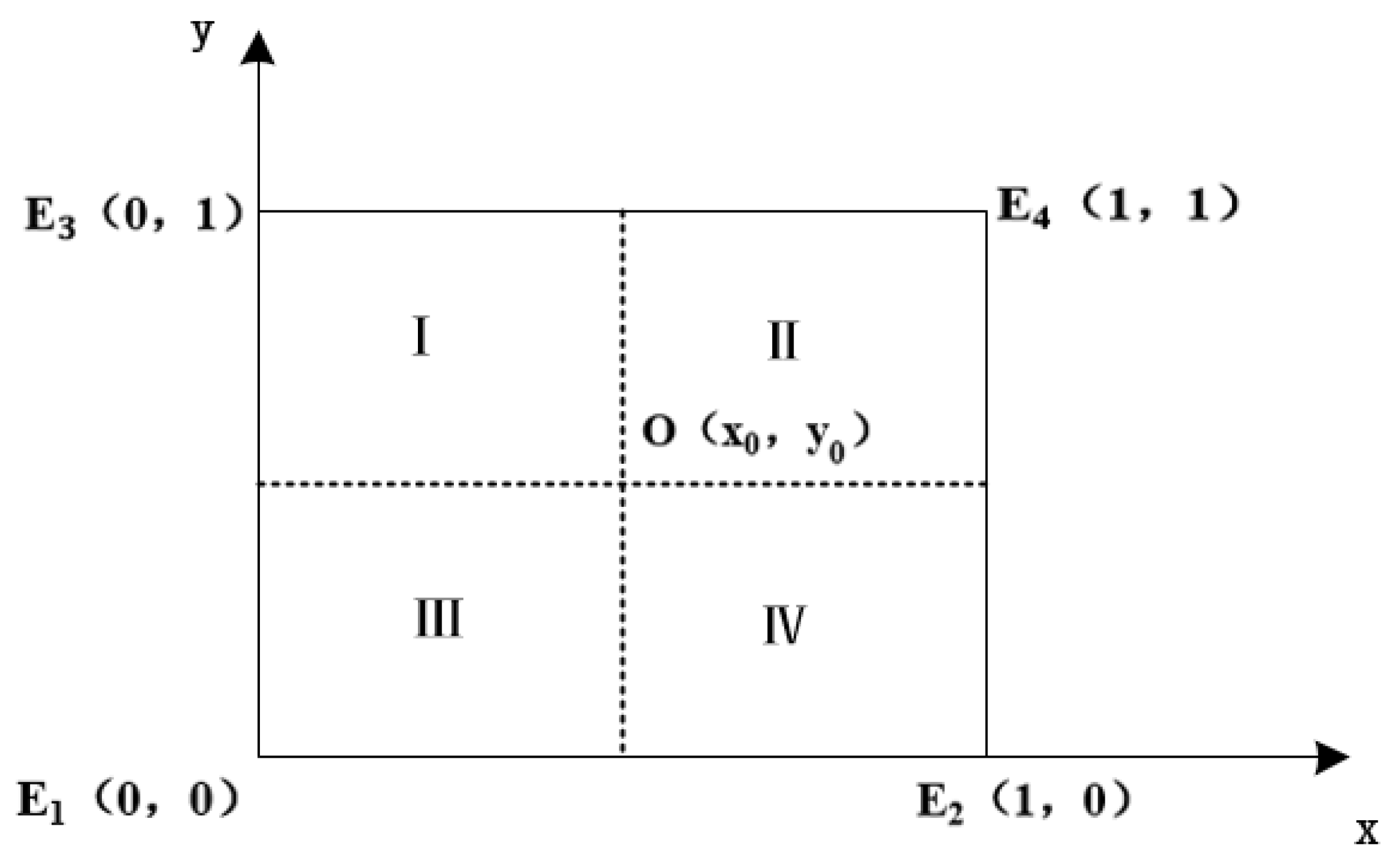
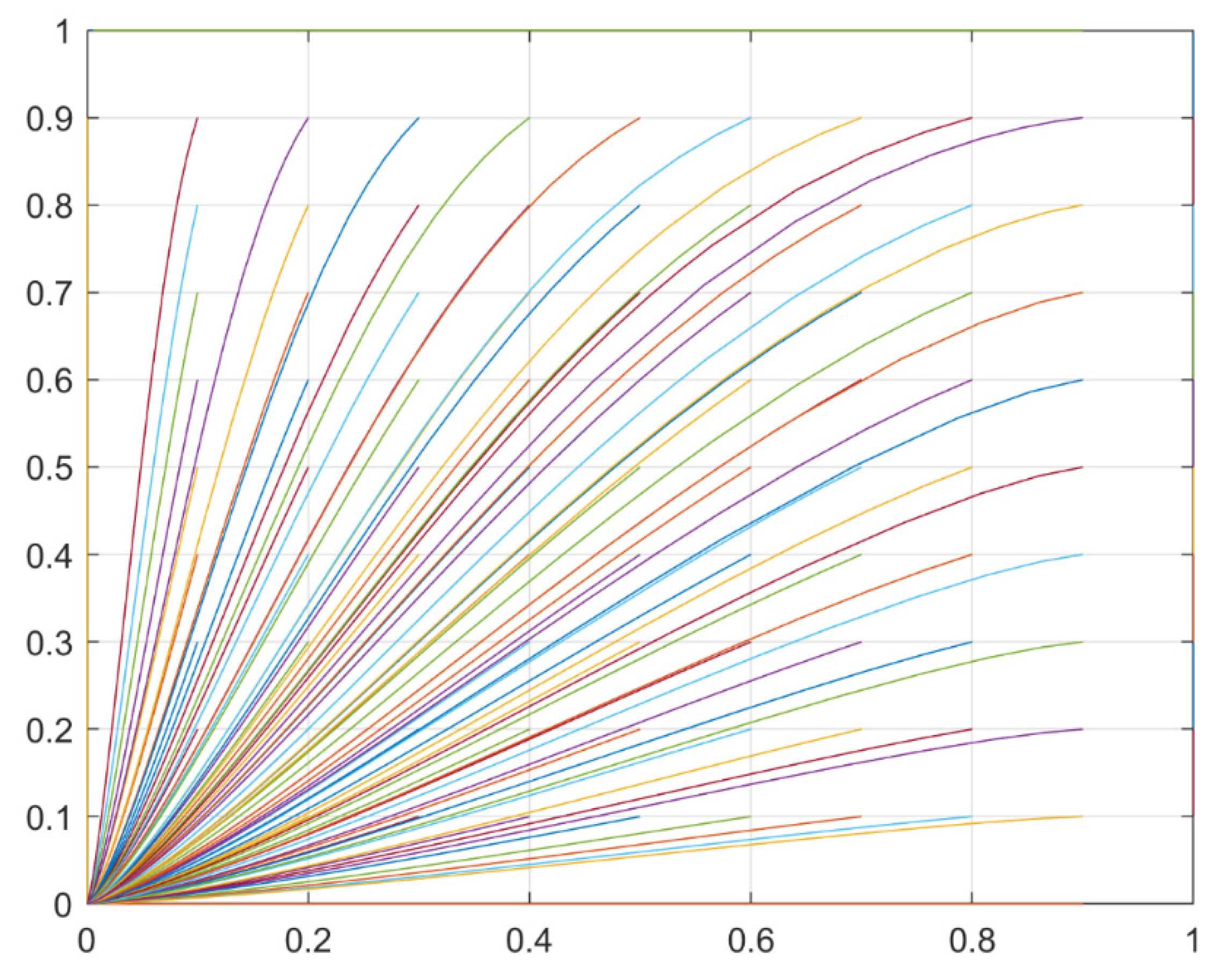
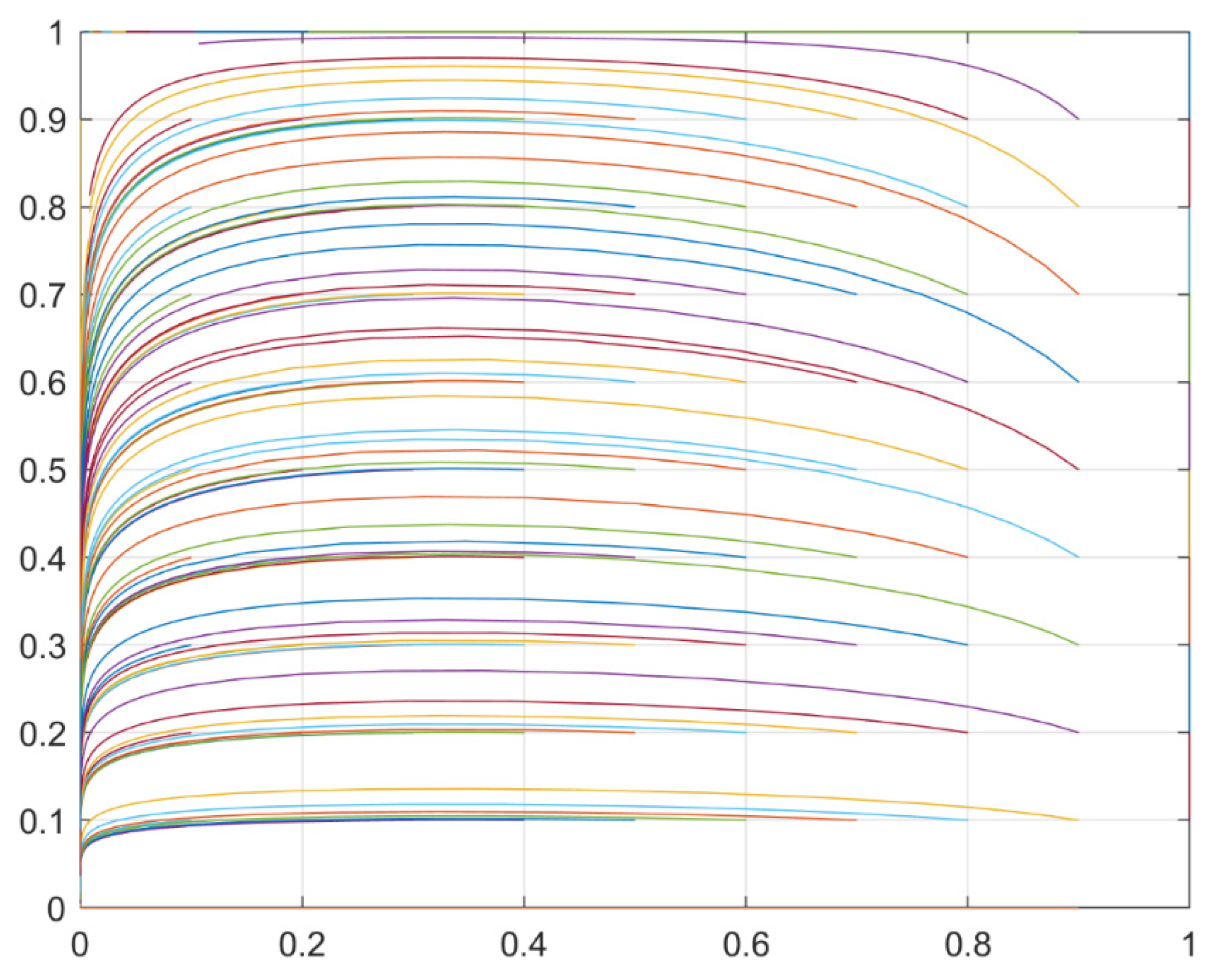
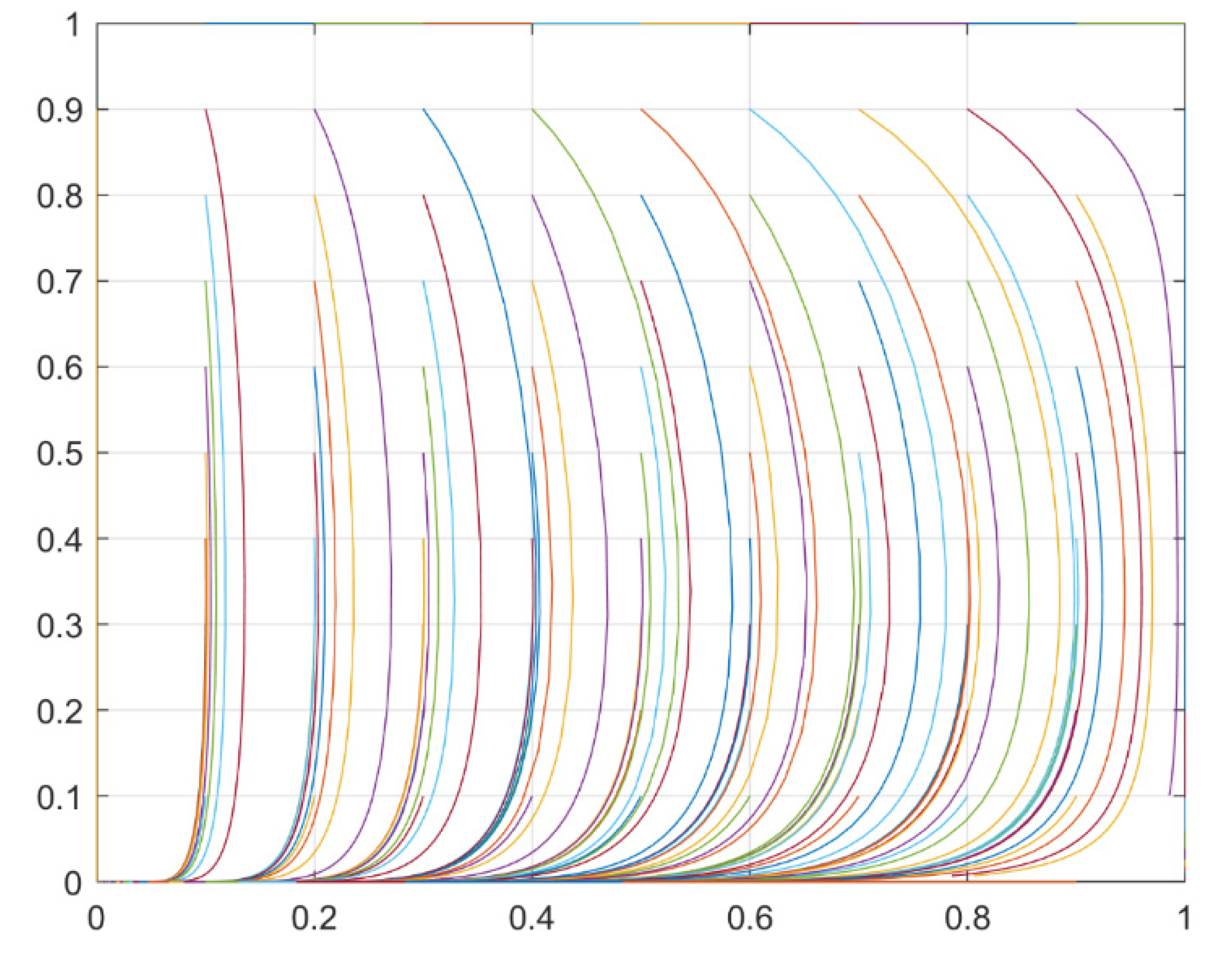
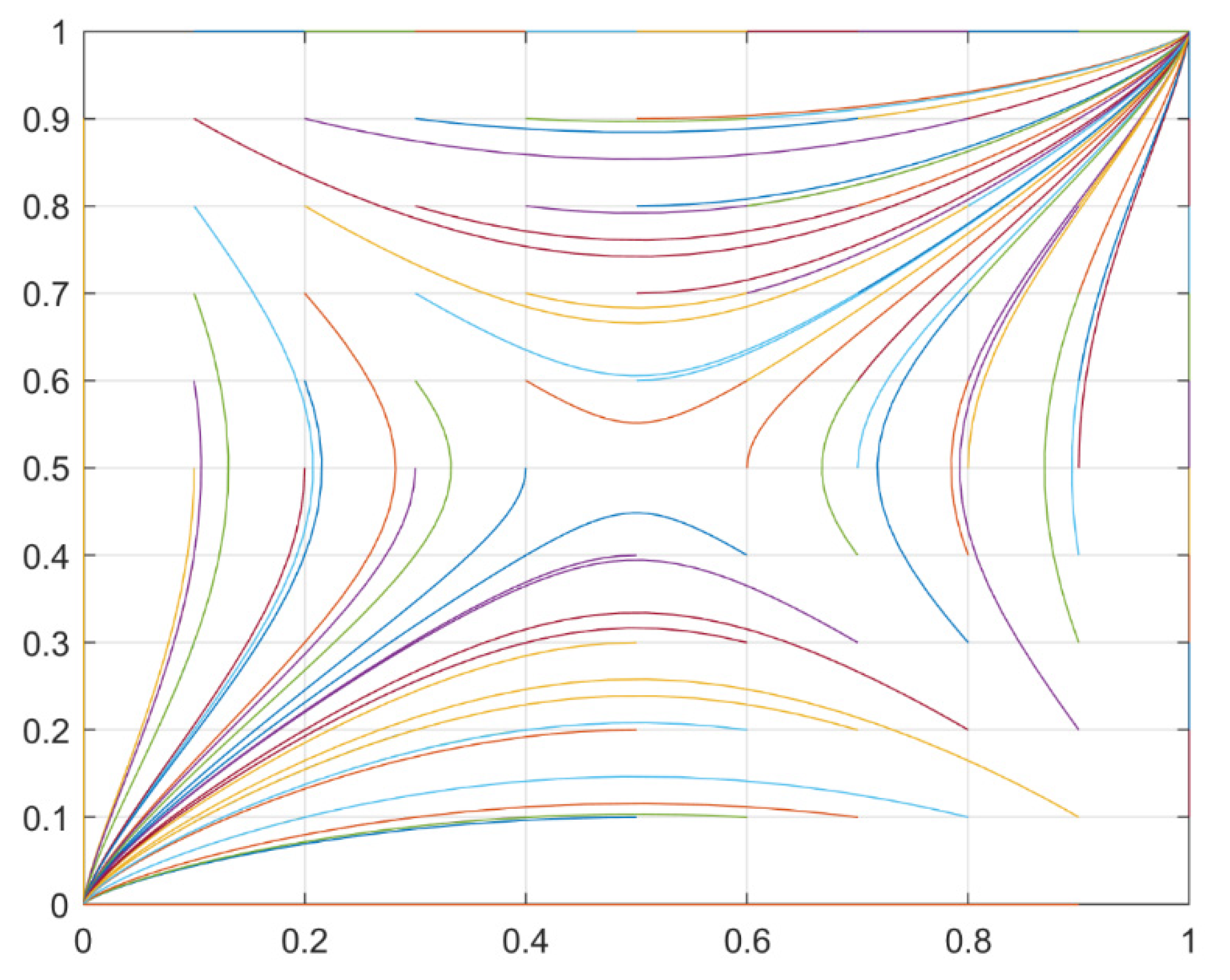
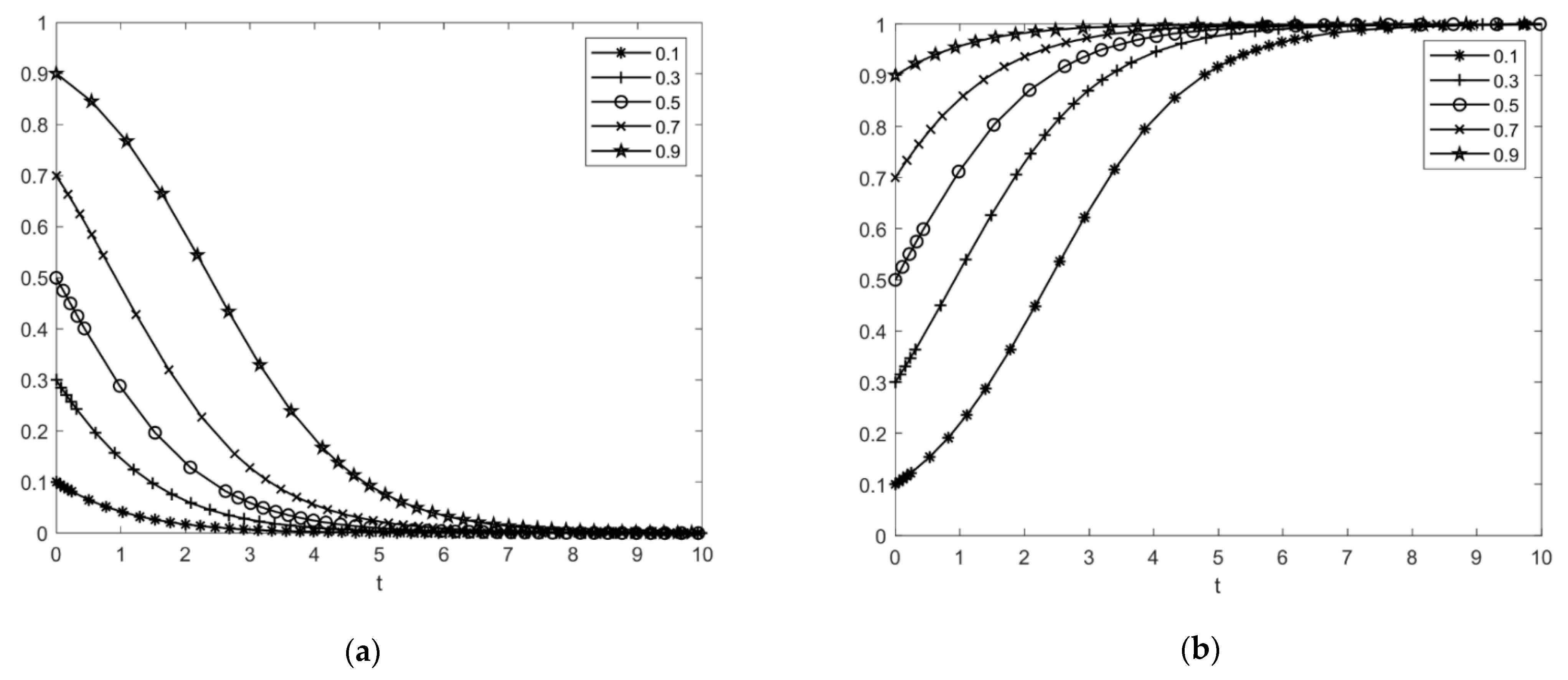


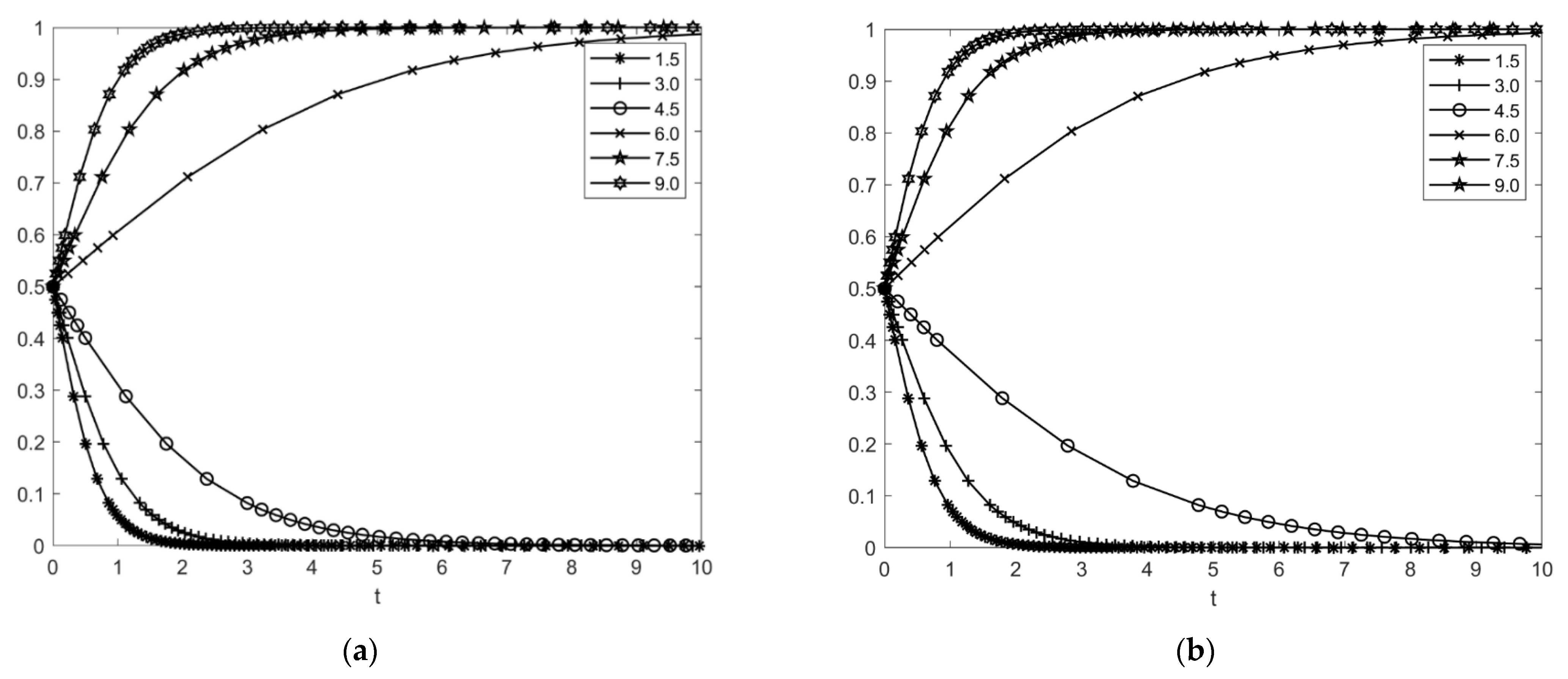
| Positive Cooperation | Negative Cooperation | |
|---|---|---|
| Positive Cooperation | ||
| Negative cooperation |
| Parameter | Definition |
|---|---|
| net income | |
| income distribution | |
| the positive spillover coefficient | |
| the negative spillover coefficient | |
| the liquidated damages | |
| indirect income or punishment | |
| the percentages of positive cooperation in construction enterprise 1 | |
| the percentages of positive cooperation in construction enterprise 2 | |
| the positive cooperation income of construction enterprise 1 | |
| the negative cooperation income of construction enterprise 1 | |
| the expected income of construction enterprise 1 | |
| the positive cooperation income of construction enterprise 2 | |
| the negative cooperation income of construction enterprise 2 | |
| the expected income of construction enterprise 2 | |
| replication dynamics equation for construction enterprise 1 | |
| replication dynamics equation for construction enterprise 2 |
| Parameters | ||||||
|---|---|---|---|---|---|---|
| values | 10 | 0.45 | 1.5 | 0.6 | 2 | 1.5 |
Publisher’s Note: MDPI stays neutral with regard to jurisdictional claims in published maps and institutional affiliations. |
© 2021 by the authors. Licensee MDPI, Basel, Switzerland. This article is an open access article distributed under the terms and conditions of the Creative Commons Attribution (CC BY) license (https://creativecommons.org/licenses/by/4.0/).
Share and Cite
Wang, Q.; Lai, W.; Ding, M.; Qiu, Q. Research on Cooperative Behavior of Green Technology Innovation in Construction Enterprises Based on Evolutionary Game. Buildings 2022, 12, 19. https://doi.org/10.3390/buildings12010019
Wang Q, Lai W, Ding M, Qiu Q. Research on Cooperative Behavior of Green Technology Innovation in Construction Enterprises Based on Evolutionary Game. Buildings. 2022; 12(1):19. https://doi.org/10.3390/buildings12010019
Chicago/Turabian StyleWang, Qing’e, Wei Lai, Mengmeng Ding, and Qi Qiu. 2022. "Research on Cooperative Behavior of Green Technology Innovation in Construction Enterprises Based on Evolutionary Game" Buildings 12, no. 1: 19. https://doi.org/10.3390/buildings12010019
APA StyleWang, Q., Lai, W., Ding, M., & Qiu, Q. (2022). Research on Cooperative Behavior of Green Technology Innovation in Construction Enterprises Based on Evolutionary Game. Buildings, 12(1), 19. https://doi.org/10.3390/buildings12010019







